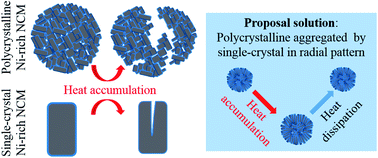A single-crystal nickel-rich material as a highly stable cathode for lithium-ion batteries†
Abstract
The commonly used polycrystalline Ni-rich LiNi0.8Co0.1Mn0.1O2 (NCM811) cathode materials suffer from electrochemical degradation such as rapid impedance growth and capacity decay due to their intrinsically vulnerable grain-boundary fracture during battery cycling. To understand the effect of the aging mechanism of the nanocrystalline grains on the cycling performance, we have investigated polycrystalline (P-NCM811) and single-crystal (S-NCM811) nanoscale cathode materials and compared their impact on the battery performance. Interestingly, the capacity retention of the S-NCM 811 cathode has faded slowly after 200 cycles at 1C rate with a capacity retention of 80%, compared to the P-NCM 811 cathode with a value of 72%. In situ X-ray diffraction and ex situ scanning electron microscopy analyses reveal that the irreversible structural and phase changes have impacted the performance of P-NCM811, especially under varied temperature conditions. The surface side reaction and internal crystal domains that generate structural defects were found to impair the diffusion of lithium ions and, eventually, lead to rapid capacity fading and poor cycling stability. These results give guidance on further developments in the particle morphology to dissipate the intrinsic lattice strain, stabilize the surface, and modify the composition to finally attain a satisfactory cycling stability.



 Please wait while we load your content...
Please wait while we load your content...